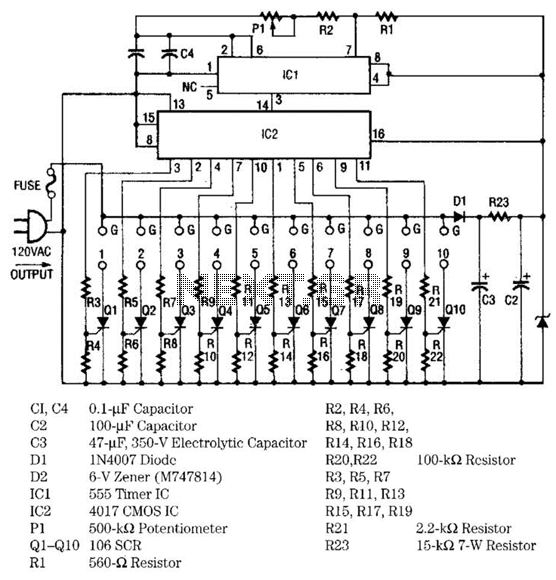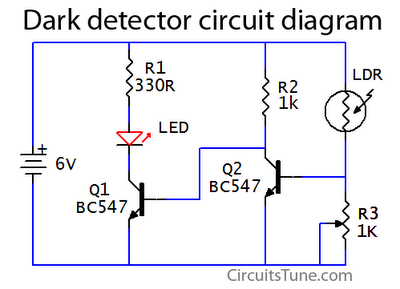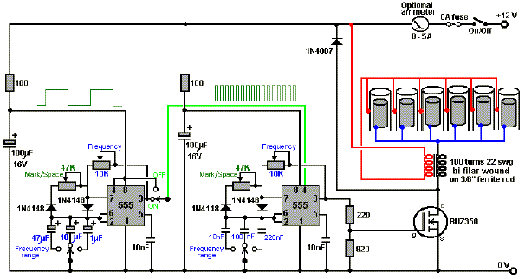
Fading Leds Circuit

This circuit operates two LED strips in pulsing mode, where one LED strip transitions from an off state to gradually lighting up, then dimming, while the other LED strip performs the opposite action. Each strip can consist of 2 to 5 LEDs powered by a 9V supply. The two operational amplifiers within IC1 create a triangular wave generator.
The circuit utilizes a dual operational amplifier integrated circuit (IC1) to generate a triangular waveform, which serves as the control signal for the LED strips. The output of the triangular wave generator is configured to drive the LED strips in a complementary manner. As one strip illuminates, the other fades, creating a visually appealing pulsing effect.
The LED strips are connected to the output of the op-amps through appropriate current-limiting resistors to ensure that the LEDs operate within their specified current ratings. The number of LEDs in each strip can be adjusted between 2 to 5, depending on the desired brightness and power consumption. Each LED strip receives a 9V supply, making it suitable for standard LED configurations while ensuring efficient operation.
To achieve the pulsing effect, the frequency of the triangular wave can be adjusted by varying the resistor and capacitor values in the timing circuit associated with the op-amps. This allows for customization of the pulsing speed, enabling the user to create different lighting effects based on preference. Additionally, the circuit can be designed to include a potentiometer for real-time adjustment of the pulse width or frequency, further enhancing the versatility of the LED lighting system.
Overall, this circuit design effectively combines the properties of operational amplifiers with LED technology to create an engaging lighting experience, suitable for decorative applications or mood lighting.This circuit operates two LED strips in pulsing mode, i.e. one LED strip goes from off state, lights up gradually, then dims gradually, etc. while the other LED strip does the contrary. Each strip can be made up from 2 to 5 LEDs at 9V supply. The two Op-Amps contained into IC1 form a triangular wave generator.. 🔗 External reference
The circuit utilizes a dual operational amplifier integrated circuit (IC1) to generate a triangular waveform, which serves as the control signal for the LED strips. The output of the triangular wave generator is configured to drive the LED strips in a complementary manner. As one strip illuminates, the other fades, creating a visually appealing pulsing effect.
The LED strips are connected to the output of the op-amps through appropriate current-limiting resistors to ensure that the LEDs operate within their specified current ratings. The number of LEDs in each strip can be adjusted between 2 to 5, depending on the desired brightness and power consumption. Each LED strip receives a 9V supply, making it suitable for standard LED configurations while ensuring efficient operation.
To achieve the pulsing effect, the frequency of the triangular wave can be adjusted by varying the resistor and capacitor values in the timing circuit associated with the op-amps. This allows for customization of the pulsing speed, enabling the user to create different lighting effects based on preference. Additionally, the circuit can be designed to include a potentiometer for real-time adjustment of the pulse width or frequency, further enhancing the versatility of the LED lighting system.
Overall, this circuit design effectively combines the properties of operational amplifiers with LED technology to create an engaging lighting experience, suitable for decorative applications or mood lighting.This circuit operates two LED strips in pulsing mode, i.e. one LED strip goes from off state, lights up gradually, then dims gradually, etc. while the other LED strip does the contrary. Each strip can be made up from 2 to 5 LEDs at 9V supply. The two Op-Amps contained into IC1 form a triangular wave generator.. 🔗 External reference




